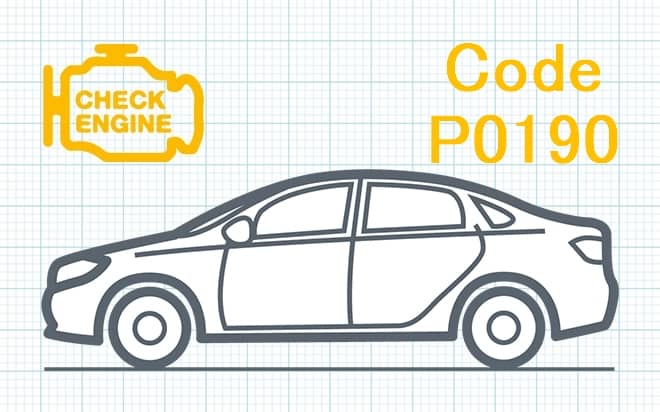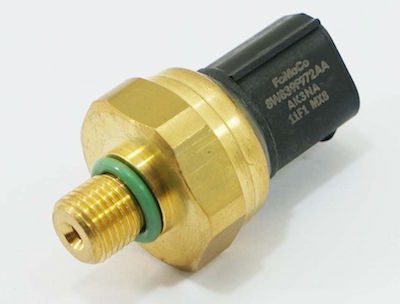
P0190 Fuel rail pressure sensor circuit "A"
Content
- OBD-II Trouble Code - P0190 - Data Sheet
- What does trouble code P0190 mean?
- Symptoms
- Causes of the P0190 code
- Diagnostic and repair procedures
- P0190 BRAND SPECIFIC INFORMATION
- Common Mistakes When Diagnosing Code P0190
- How serious is the P0190 code?
- What repairs can fix code P0190?
- Additional comments to consider regarding code P0190
- Need more help with your p0190 code?
OBD-II Trouble Code - P0190 - Data Sheet
P0190 - Fuel rail pressure sensor "A" circuit
What does trouble code P0190 mean?
This Generic Transmission / Engine DTC usually applies to most fuel injection engines, both gasoline and diesel, since 2000. The code applies to all manufacturers such as Volvo, Ford, GMC, VW, etc.
This code strictly refers to the fact that the input signal from the fuel rail pressure (FRP) sensor will fall below the calibrated limit for the calibrated amount of time. This could be a mechanical failure or an electrical failure, depending on the vehicle manufacturer, fuel type and fuel system.
Troubleshooting steps may vary depending on the manufacturer, type of rail pressure system, type of rail pressure sensor, and wire colors.
Symptoms
Symptoms of a P0190 engine code may include:
- Malfunction Indicator Lamp (MIL) illuminated
- Lack of power
- Engine cranks but won't start
Causes of the P0190 code
Possible reasons for setting this code:
- Open circuit VREF
- Damaged FRP sensor
- Excessive resistance in the VREF circuit
- Little or no fuel
- FRP wiring is open or shorted
- Defective FRP circuit electrical circuit
- Faulty fuel pump
Diagnostic and repair procedures
A good starting point is always to check the Technical Service Bulletins (TSB) for your particular vehicle. Your problem may be a known issue with a known manufacturer-released fix and could save you time and money while troubleshooting.
Then find the fuel rail pressure sensor on your specific vehicle. It might look something like this:

Once detected, visually inspect the connectors and wiring. Look for scuffs, scuffs, exposed wires, burn marks, or molten plastic. Disconnect the connectors and carefully inspect the terminals (metal parts) inside the connectors. See if they look rusty, burnt, or perhaps green compared to the usual metallic color you're probably used to seeing. If terminal cleaning is required, you can purchase electrical contact cleaner at any parts store. If this is not possible, find 91% rubbing alcohol and a light plastic bristle brush to clean them. Then let them air dry, take a dielectric silicone compound (the same material they use for bulb holders and spark plug wires) and place where the terminals make contact.
If you have a scan tool, clear the diagnostic trouble codes from memory and see if the code returns. If this is not the case, then there is most likely a connection problem.
If the code returns, we will need to test the sensor and associated circuits. Usually there are 3 wires connected to the FRP sensor. Disconnect the harness from the FRP sensor. Use a digital volt ohmmeter (DVOM) to check the 5V power supply circuit going to the sensor to make sure it is on (red wire to 5V power supply circuit, black wire to good ground). If the sensor is 12 volts when it should be 5 volts, repair the wiring from the PCM to the sensor for a short to 12 volts or possibly a faulty PCM.
If this is normal, with the DVOM, make sure you have 5V in the FRP sensor signal circuit (red wire to sensor signal circuit, black wire to good ground). If there is no 5 volts on the sensor, or if you see 12 volts on the sensor, repair the wiring from the PCM to the sensor, or again, possibly a faulty PCM.
If this is normal, make sure you have a good ground connection at the FRP sensor. Connect a test lamp to the positive of the 12V battery (red terminal) and touch the other end of the test lamp to the ground circuit that leads to the FRP sensor circuit ground. If the test lamp does not light up, it indicates a faulty circuit. If it illuminates, wiggle the wire harness going to the FRP sensor to see if the test lamp blinks, indicating an intermittent connection.
If all tests pass, but you still get the P0190 code, it most likely indicates a PCM failure. Before replacing the PCM is warranted, it is recommended that you perform a hard reset (disconnect the battery). It may also be necessary to replace the fuel rail pressure sensor.
CAUTION! On diesel engines with common rail fuel systems: if a fuel rail pressure sensor is suspected, you can have a professional install the sensor for you. This sensor may be installed separately or may be part of the fuel rail. In any case, the fuel rail pressure of these diesel engines at warm idle is typically at least 2000 psi, and under load can be well over 35,000 psi. If not properly sealed, this fuel pressure can cut the skin, and diesel fuel has bacteria in it that can cause blood poisoning.
P0190 BRAND SPECIFIC INFORMATION
- P0190 CHE01ROLET Fuel rail pressure sensor circuit malfunction
- P0190 FORD Fuel Rail Pressure Sensor Circuit Malfunction
- P0190 GMC Fuel Rail Pressure Sensor Circuit Malfunction
- P0190 LEXUS Rail Pressure Sensor Circuit Malfunction
- P0190 LINCOLN Fuel Rail Pressure Sensor Circuit Malfunction
- P0190 MAZDA Fuel Rail Pressure Sensor Circuit Malfunction
- P0190 MERCEDES-BENZ Fuel Rail Pressure Sensor Circuit Malfunction
- P0190 MERCURY Fuel Rail Pressure Sensor Circuit Malfunction
- P0190 VOLKSWAGEN Fuel Rail Pressure Sensor Circuit Malfunction
Common Mistakes When Diagnosing Code P0190
In many cases, the problem is that there is no gasoline in the fuel tank, and filling up with gas will solve the problem. Therefore, replacing the fuel rail pressure sensor should not be a top priority.
How serious is the P0190 code?
DTC P0190 is considered serious. Drivability problems that manifest as symptoms of this code make driving difficult and potentially dangerous. Therefore, DTC P0190 requires immediate attention.
What repairs can fix code P0190?
- Checking the fuel level and refueling if necessary
- Repair any broken or shorted wires
- Repairing rusted wiring or connectors
- Replacing a Clogged Fuel Filter
- Replacing the fuel pump relay
- Replacing the fuel pump fuse
- Replacing the fuel pump
- Replacing the pressure sensor in the fuel rail
Additional comments to consider regarding code P0190
Be sure to check the fuel level, because it is possible that the solution is to simply fill the car with gasoline. Low fuel has been known to trigger the P0190 trouble code. Also, be sure to check all fuel system components before replacing the fuel rail pressure sensor.
Need more help with your p0190 code?
If you still need help with DTC P0190, post a question in the comments below this article.
NOTE. This information is provided for informational purposes only. It is not intended to be used as a repair recommendation and we are not responsible for any action you take on any vehicle. All information on this site is protected by copyright.
One comment
Gelson Ronei
Good afternoon, I have a jumper and it is giving fault code P0190, even with the pressure sensor connector disconnected I have a stuck value on the 360 bar Scanner, the car won't start, I've already checked the engine harness and found three broken wires but it didn't solve the problem. I need help has anyone ever had a problem like this…..